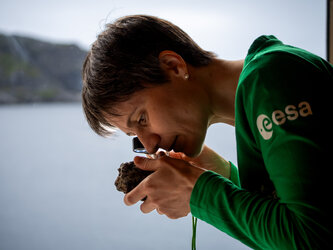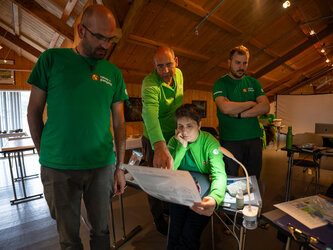Accept all cookies Accept only essential cookies See our Cookie Notice

About ESA
The European Space Agency (ESA) is Europe’s gateway to space. Its mission is to shape the development of Europe’s space capability and ensure that investment in space continues to deliver benefits to the citizens of Europe and the world.
Highlights
ESA - United space in Europe
This is ESA ESA facts Member States & Cooperating States Funding Director General Top management For Member State Delegations European vision European Space Policy ESA & EU Space Councils Responsibility & Sustainability Annual Report Calendar of meetings Corporate newsEstablishments & sites
ESA Headquarters ESA ESTEC ESA ESOC ESA ESRIN ESA EAC ESA ESAC Europe's Spaceport ESA ESEC ESA ECSAT Brussels Office Washington OfficeWorking with ESA
Business with ESA ESA Commercialisation Gateway Law at ESA Careers Cyber resilience at ESA IT at ESA Newsroom Partnerships Merchandising Licence Education Open Space Innovation Platform Integrity and Reporting Administrative Tribunal Health and SafetyMore about ESA
History ESA Historical Archives Exhibitions Publications Art & Culture ESA Merchandise Kids Diversity ESA Brand Centre ESA ChampionsLatest
Space in Member States
Find out more about space activities in our 23 Member States, and understand how ESA works together with their national agencies, institutions and organisations.
Science & Exploration
Exploring our Solar System and unlocking the secrets of the Universe
Go to topicAstronauts
Missions
Juice Euclid Webb Solar Orbiter BepiColombo Gaia ExoMars Cheops Exoplanet missions More missionsActivities
International Space Station Orion service module Gateway Concordia Caves & Pangaea BenefitsLatest
Space Safety
Protecting life and infrastructure on Earth and in orbit
Go to topicAsteroids
Asteroids and Planetary Defence Asteroid danger explained Flyeye telescope: asteroid detection Hera mission: asteroid deflection Near-Earth Object Coordination CentreSpace junk
About space debris Space debris by the numbers Space Environment Report In space refuelling, refurbishing and removingSafety from space
Clean Space ecodesign Zero Debris Technologies Space for Earth Supporting Sustainable DevelopmentLatest
Applications
Using space to benefit citizens and meet future challenges on Earth
Go to topicObserving the Earth
Observing the Earth Future EO Copernicus Meteorology Space for our climate Satellite missionsCommercialisation
ESA Commercialisation Gateway Open Space Innovation Platform Business Incubation ESA Space SolutionsLatest
Enabling & Support
Making space accessible and developing the technologies for the future
Go to topicBuilding missions
Space Engineering and Technology Test centre Laboratories Concurrent Design Facility Preparing for the future Shaping the Future Discovery and Preparation Advanced Concepts TeamSpace transportation
Space Transportation Ariane Vega Space Rider Future space transportation Boost! Europe's Spaceport Launches from Europe's Spaceport from 2012Latest

Moon stance
Thank you for liking
You have already liked this page, you can only like it once!
ESA astronauts Alexander Gerst and Samantha Cristoforetti stand in a Norwegian fjord escorted by a waning crescent Moon. The pair is fully equipped for their first field expedition on lunar geology, as part of an intensive training week with ESA’s PANGAEA course.
Alexander and Samantha are wearing a digitally enhanced geology toolkit: a belt with a microscope, a spectrometer and a chest rig with a tablet to record their movements and document their findings. The astronauts also carry a rock hammer, a magnifying lens, sampling bags, a magnet and cue cards to help them identify rocks for science.
The duo was about to embark on a hunt to locate rare Earth rocks similar to those found in the heavily cratered highlands of the Moon – anorthosites. These rocks are billions of years old and originated from deep within the Earth. Anorthosites have been carved by Arctic glaciers in the mountains surrounding the small fishing village of Nusfjord.
Top European planetary scientists follow the astronauts closely to fill any knowledge gaps the might have about lunar science. The trainees have gained an extensive set of geological knowledge and skills, and are trained to work with scientists and explore autonomously as if they were exploring the surface of the Moon.
Alexander and Samantha are also supported by a series of tools and an app, a sort of ‘space tablet’ called the Electronic Field Book that helps them identify and record minerals and rocks, interact with a remote science team and collect the promising samples.
The digital tool is tested in each PANGAEA edition to support lunar exploration with future NASA Artemis missions in mind.
Follow their lunar steps on ESA’s PANGAEA blog, Twitter and Flickr.
-
CREDIT
ESA–V. Crobu -
LICENCE
ESA Standard Licence

ESA astronaut Alexander Gerst during geology field e…

ESA astronaut Samantha Cristoforetti analyses rock sample

ESA astronaut Samantha Cristoforetti during geology lesson

The Moon in a fjord















 Germany
Germany
 Austria
Austria
 Belgium
Belgium
 Denmark
Denmark
 Spain
Spain
 Estonia
Estonia
 Finland
Finland
 France
France
 Greece
Greece
 Hungary
Hungary
 Ireland
Ireland
 Italy
Italy
 Luxembourg
Luxembourg
 Norway
Norway
 The Netherlands
The Netherlands
 Poland
Poland
 Portugal
Portugal
 Czechia
Czechia
 Romania
Romania
 United Kingdom
United Kingdom
 Slovenia
Slovenia
 Sweden
Sweden
 Switzerland
Switzerland
























